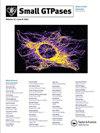An ultra-sensitive method to detect mutations in human RAS templates
Q2 Biochemistry, Genetics and Molecular Biology
引用次数: 0
Abstract
ABSTRACT The RAS family of small GTPases is mutated in roughly a fifth of human cancers. Hotspot point mutations at codons G12, G13, and Q61 account for 95% of all these mutations, which are well established to render the encoded proteins oncogenic. In humans, this family comprises three genes: HRAS, NRAS, and KRAS. Accumulating evidence argues that oncogenic RAS point mutations may be initiating, as they are often truncal in human tumours and capable of inducing tumorigenesis in mice. As such, there is great interest in detecting oncogenic mutation in the RAS genes to understand the origins of cancer, as well as for early detection purposes. To this end, we previously adapted the microbial ultra-sensitive M aximum D epth S equencing (MDS) assay for the murine Kras gene, which was capable of detecting oncogenic mutations in the tissues of mice days after carcinogen exposure, essentially capturing the very first step in tumour initiation. Given this, we report here the adaption and details of this assay to detect mutations in a human KRAS sequence at an analytic sensitivity of one mutation in a million independently barcoded templates. This humanized version of MDS can thus be exploited to detect oncogenic mutations in KRAS at an incredible sensitivity and modified for the same purpose for the other RAS genes.一种检测人类RAS模板突变的超灵敏方法
RAS小GTPases家族在大约五分之一的人类癌症中发生突变。密码子G12、G13和Q61的热点突变占所有这些突变的95%,这些突变已被证实可以使编码的蛋白质致癌。在人类中,这个家族包括三个基因:HRAS、NRAS和KRAS。越来越多的证据表明,致癌的RAS点突变可能是初始的,因为它们在人类肿瘤中通常是截断的,而在小鼠中能够诱导肿瘤发生。因此,人们对检测RAS基因中的致癌突变以了解癌症的起源以及早期检测有很大的兴趣。为此,我们先前对小鼠Kras基因进行了微生物超敏感M最大D深度S序列(MDS)测定,该测定能够在致癌物暴露后几天检测小鼠组织中的致癌突变,基本上捕获了肿瘤起始的第一步。鉴于此,我们在此报告了该分析的适应性和细节,以在一百万个独立条形码模板中检测一个突变的分析灵敏度检测人类KRAS序列中的突变。因此,这种人源化的MDS可以以令人难以置信的灵敏度检测KRAS中的致癌突变,并对其他RAS基因进行同样的修饰。
本文章由计算机程序翻译,如有差异,请以英文原文为准。
求助全文
约1分钟内获得全文
求助全文
来源期刊

Small GTPases
Biochemistry, Genetics and Molecular Biology-Biochemistry
CiteScore
6.10
自引率
0.00%
发文量
6
 求助内容:
求助内容: 应助结果提醒方式:
应助结果提醒方式:


